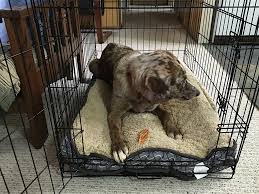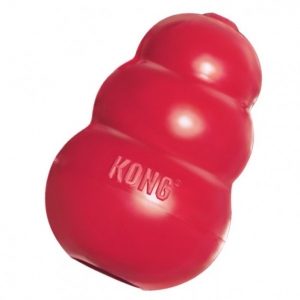Ask Crystal: Counter Surfing Dog
Welcome to “Ask Crystal,” where you can ask your pet behavior questions! You can submit your question for Crystal at the bottom of the page!
 We recently adopted a dog from your organization two weeks ago. She does well with us at home, but when we leave, she is getting into things, such as trash and paper towels. We have closed all bedrooms and bathrooms, so she has the entire living room/kitchen to roam. We also moved the trash into the garage. Today we were gone only three hours and came back to her having eaten bread from the high counter tops, knocked things off such as paper towels and knickknacks. She’s been fed and taken out to do business before we leave. We also leave her with a kong to keep her busy, but it doesn’t seem to be enough. When we first would leave her (first week) she didn’t get into things. Now she is. What are your suggestions on helping her be okay alone? Should we crate train? Or just give her more time with us?
We recently adopted a dog from your organization two weeks ago. She does well with us at home, but when we leave, she is getting into things, such as trash and paper towels. We have closed all bedrooms and bathrooms, so she has the entire living room/kitchen to roam. We also moved the trash into the garage. Today we were gone only three hours and came back to her having eaten bread from the high counter tops, knocked things off such as paper towels and knickknacks. She’s been fed and taken out to do business before we leave. We also leave her with a kong to keep her busy, but it doesn’t seem to be enough. When we first would leave her (first week) she didn’t get into things. Now she is. What are your suggestions on helping her be okay alone? Should we crate train? Or just give her more time with us?
Sincerely,
Counter Surfer
Hi Counter,
It is pretty normal for newly adopted dogs to be more reserved when they first come home. Many times, they are somewhat shut down and stressed out. As they begin to relax, their behavior can change and sometimes in ways that are less than desirable. It can take a few months for a dog to completely settle into a new home, so you won’t really see the full personality of the dog for a couple more months probably.
It is really important to find ways to manage the dog so that they are unable to practice undesirable behaviors. The more often that a dog is able to do a behavior that pays off for them the more often they are going to do that behavior. It is also really hard to teach a dog not to do something when you aren’t there. The best way to approach it is to prevent it from happening by managing the dog’s access to forbidden areas or items. How you do that really depends on the dog and the set up in your home.
Having a dog is a great way to remind us to keep the house picked up! Putting the trash in a different room is a great start. As far as the counter surfing, everyone will need to commit to keeping food off of the counters when you are not cooking. That includes wiping the counters so there isn’t any food residue the dog can lick. Dogs are optimists and opportunists so even if they find food once on the counter, they will keep coming back looking for more for a while. That also means that it doesn’t really matter to most dogs if they have already eaten. They will still try to eat the food off the counter.
 In general, I recommend crate training for newly adopted dogs. The crate is a great way to manage a dog when you can’t be there to intervene. The important word here is training. Unfortunately, we can’t jump to leaving a dog in a crate alone right away. Many times, if they have not been properly trained, they become panicky when left in a small enclosed space. When you are home, I would focus on making the crate a positive place to be. Start by tossing treats just near the crate. As she gets more comfortable you can toss the treats inside the crate and further and further back in the crate. This training requires a lot of repetition. The dog going in and out of the crate many times until they go in and seem relaxed. At that point, you can close the door for a moment and feed the dog a treat inside the cage. Let them out and repeat. As you see the dog become comfortable with the door closed, slowly increase the time that the door is closed. The next step would be to leave the room for a moment and come back. You would then slowly increase the amount of time you leave the room. I suggest that you crate train a lot while you are home so that the dog doesn’t only associate the crate with you leaving. Also, be sure not to let the dog out while they are whining or barking, wait until they can give you a few moments of quiet before letting them out. I also suggest feeding meals inside the crate or just outside the crate at first and then moving it inside the crate as they get more comfortable. There are a lot of fun methods to crate train on the internet you can search for as well. There are some dogs that panic in the crate no matter how much we try to train them. If she seems to be hurting herself to get out, stop crating immediately. Some whining and barking is normal initially but they shouldn’t be so upset that they are hurting themselves.
In general, I recommend crate training for newly adopted dogs. The crate is a great way to manage a dog when you can’t be there to intervene. The important word here is training. Unfortunately, we can’t jump to leaving a dog in a crate alone right away. Many times, if they have not been properly trained, they become panicky when left in a small enclosed space. When you are home, I would focus on making the crate a positive place to be. Start by tossing treats just near the crate. As she gets more comfortable you can toss the treats inside the crate and further and further back in the crate. This training requires a lot of repetition. The dog going in and out of the crate many times until they go in and seem relaxed. At that point, you can close the door for a moment and feed the dog a treat inside the cage. Let them out and repeat. As you see the dog become comfortable with the door closed, slowly increase the time that the door is closed. The next step would be to leave the room for a moment and come back. You would then slowly increase the amount of time you leave the room. I suggest that you crate train a lot while you are home so that the dog doesn’t only associate the crate with you leaving. Also, be sure not to let the dog out while they are whining or barking, wait until they can give you a few moments of quiet before letting them out. I also suggest feeding meals inside the crate or just outside the crate at first and then moving it inside the crate as they get more comfortable. There are a lot of fun methods to crate train on the internet you can search for as well. There are some dogs that panic in the crate no matter how much we try to train them. If she seems to be hurting herself to get out, stop crating immediately. Some whining and barking is normal initially but they shouldn’t be so upset that they are hurting themselves.
If she doesn’t tolerate crating, is there another way to arrange where she is staying so that she doesn’t have access to the kitchen? You can use puppy pens or baby gates to block off access depending on your setup. Some people like to keep the dog in a bedroom depending on what the other issues the dog has.
Ideally, we would get the dog used to being left out gradually. We suggest crating her for a while as you work on getting her used to your routine and the rules of the house. If you had a puppy, you may need to crate the dog when you leave for up to a couple years as they get through the teething phase. If you have an older dog it may only be a few months. There are some dogs that will always need to be crated but I don’t think that is the norm. A tactic to start giving some freedom is to give the dog a short period of freedom and see how they do. I might leave to run an errand and leave the dog alone for thirty minutes and see how they did. As they begin show us that they can be trusted, we can build up the time they are left out.
Dogs can be destructive out of boredom and excess energy. You may want to take a long walk before you need to leave so that you can feel like she at least has some of the energy out. It doesn’t guarantee that she won’t be destructive, but boredom is a big issue for a lot of dogs. Another great way to beat excess energy is through training. Training uses brain energy that really helps to tire dogs out and obviously has practical uses. One of the first things that I really like to work on initially are very practical exercises like down stays so that I can manage the dog when I am cooking or eating. Wait is a really useful behavior to teach impulse control and to keep the dog from bolting the door. I also always teach dogs to leave it. It is a useful cue to teach for a dog that is getting into some things they shouldn’t be in front of you.
 It sounds like you have been giving her Kongs which is a great idea. I do suggest giving the dog a frozen kong to lick at any time you need to put them in the crate. I usually soak the dog’s kibble in water or broth and freeze for a few hours. I also always suggest that dogs eat exclusively from enrichment toys. An average dog’s life is pretty boring and finding creative ways to feed makes their life more interesting and burns energy. Licking also helps soothe anxiety so it could give her something productive to do if she is anxious. There is so much information online about making your own enrichment toys and great Facebook groups with people sharing their enrichment ideas if you are interested in learning more.
It sounds like you have been giving her Kongs which is a great idea. I do suggest giving the dog a frozen kong to lick at any time you need to put them in the crate. I usually soak the dog’s kibble in water or broth and freeze for a few hours. I also always suggest that dogs eat exclusively from enrichment toys. An average dog’s life is pretty boring and finding creative ways to feed makes their life more interesting and burns energy. Licking also helps soothe anxiety so it could give her something productive to do if she is anxious. There is so much information online about making your own enrichment toys and great Facebook groups with people sharing their enrichment ideas if you are interested in learning more.
As she gets used to the routine of your house and learns that you are going to come back, she will hopefully start to get used to being alone. Do your best to create an environment that keeps her from practicing bad behavior and work on teaching her good behaviors. It is possible she did not live inside previously or was allowed to practice bad behaviors so you may be having to undo years of improper management. It may take a little longer than you would hope but consistency and patience is key here.
Until next time,
Crystal







